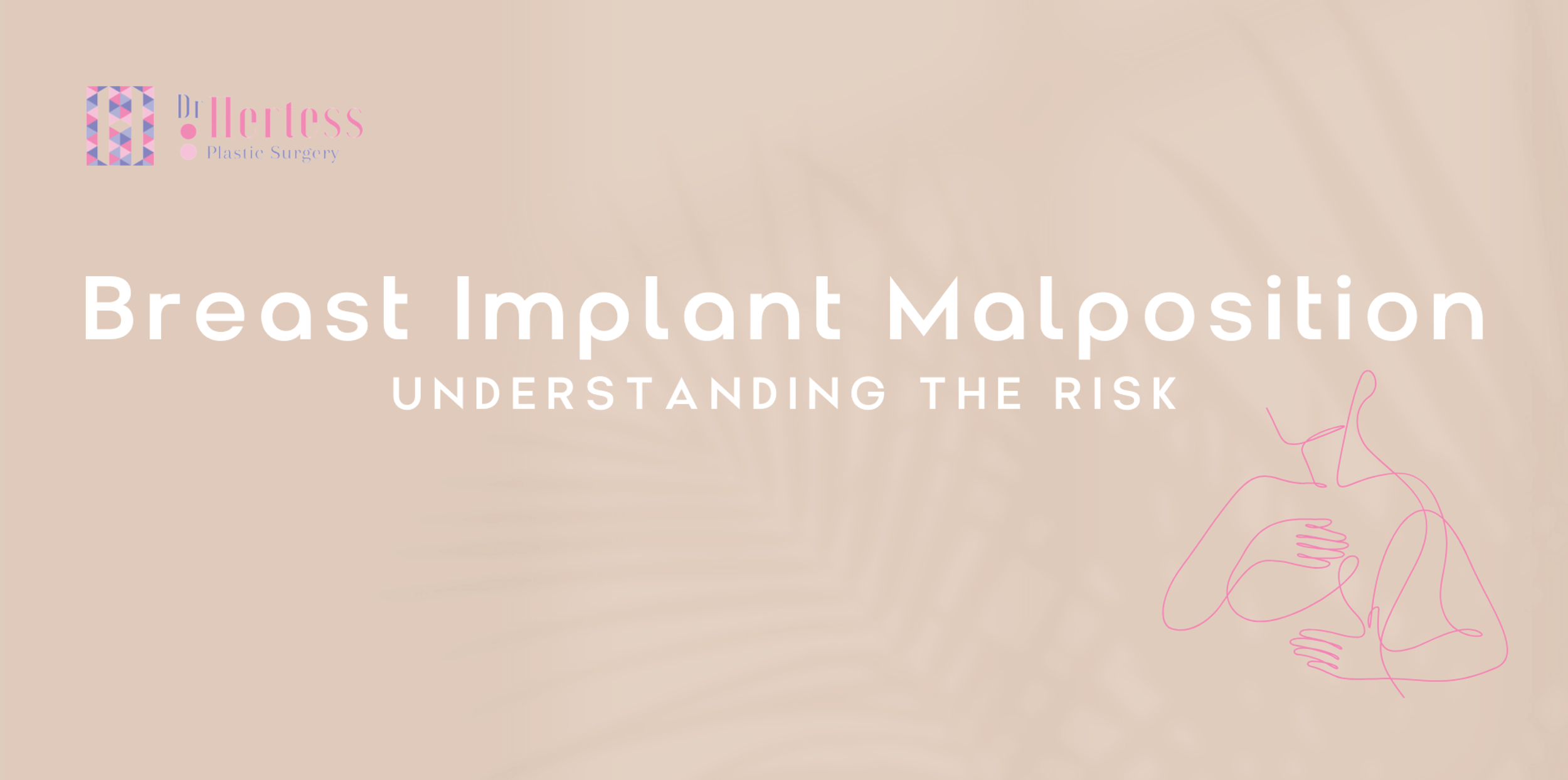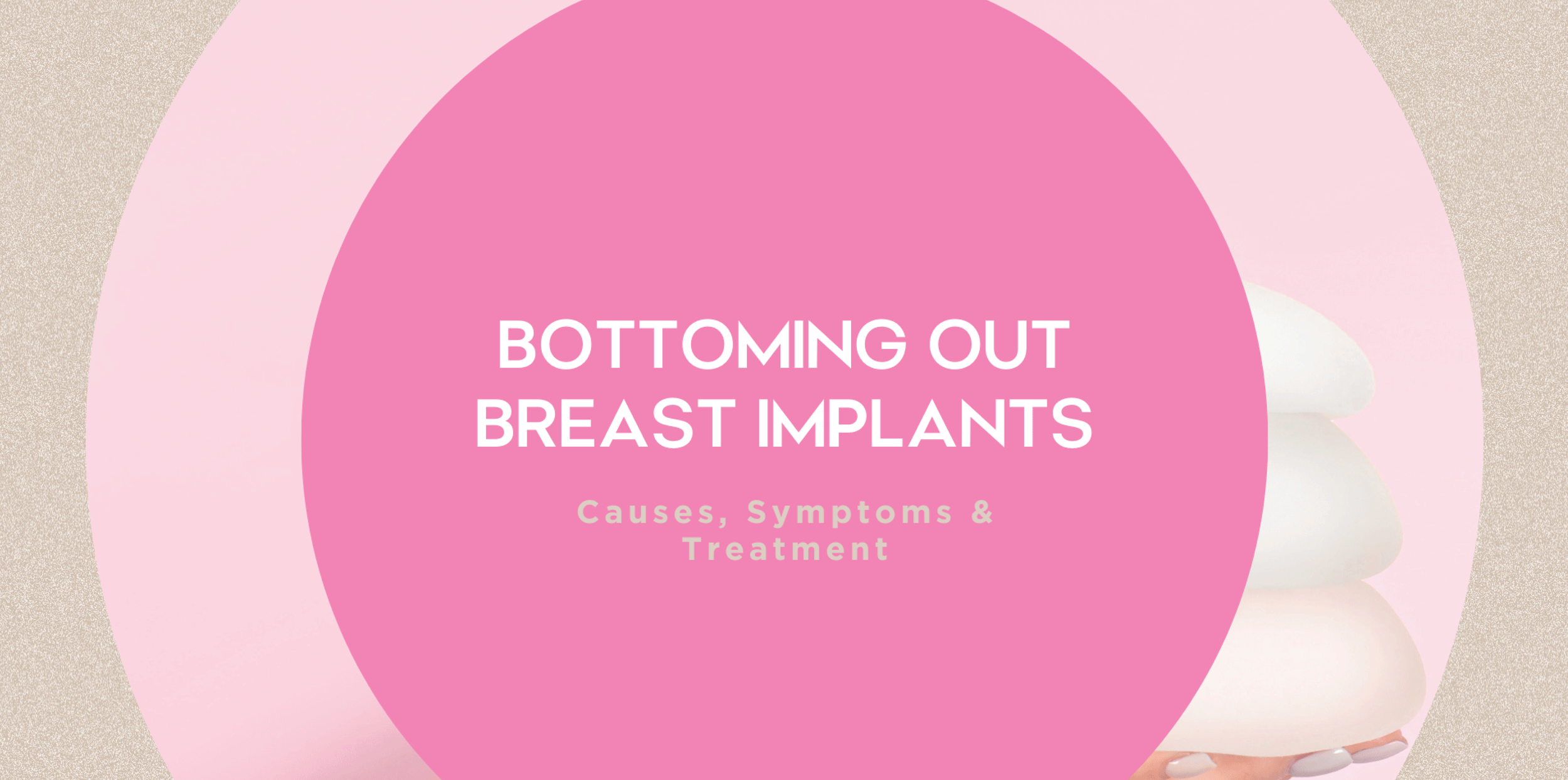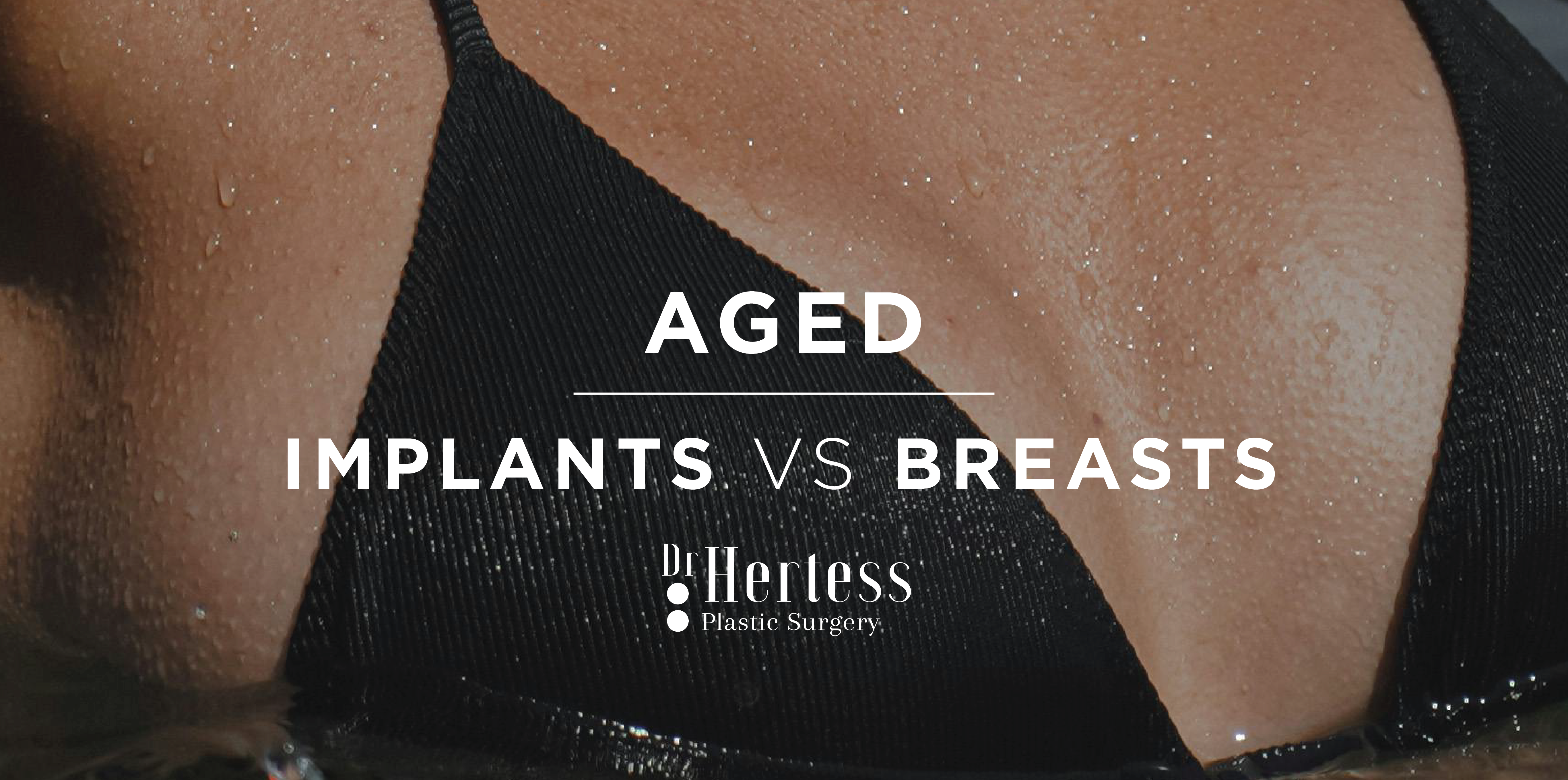Breast Implant Malposition: Understanding The Risk

Many women face the risk of breast implant malposition, commonly known as implant shifting, after breast augmentation surgery. This can be a challenging and distressing experience for patients.
Dr Hertess is a Specialist Plastic Surgeon and is here to guide you every step of the way. This blog will help you understand what breast implant displacement involves, what causes it, the signs to look out for, and effective ways to treat it.
To make things even more clear, we will also be sharing implant displacement pictures. By comprehensively understanding these risks, you can make more informed decisions about your own breast augmentation journey.
What is Breast Implant Displacement?
Breast implant malposition occurs when breast implants shift from their original position in the breast pocket. This can result in an uneven, distorted appearance of the breasts, causing dissatisfaction and discomfort for the patient.
This can happen and is not a surgical error, where breast implants become loose, fall out of pocket, or shift. Breast implants can shift outwards to the side, downwards, upwards or towards the center of the chest These types of displacement and their breast revision options will be discussed in more detail below.
Breast Implant Displacement Symptoms
Image 1: Ptosis (sagging) of breast implants. Real patient of Dr Hertess Specialist Plastic Surgeon.
Women commonly ask, "How do you know if your breast implant has shifted?"
This complication is an easy one to spot. Here are some tell-tale symptoms that your breast implant has shifted:
- Significant asymmetry in the appearance of breasts
- Nipples point in different directions and breasts are unequal in appearance
- The feeling of an implant moving under the skin or towards the armpit, particularly when lying down
- Breasts that appear close together or too far apart
Other than these physical symptoms, patients may also experience emotional discomfort due to the changes in their breast appearance.
What Causes Implant Malposition? Causes of Implant Displacement
Getting implants isn't always straightforward - factors such as surgical techniques, the size and shape of the implant, breast implant myths and even your body's healing process can all impact the final result.
"Just as with a new pair of heels, there's a 'breaking-in' period for implants too - typically around three months after augmentation surgery. But sometimes, things don't go as planned and we run into what's known as implant displacement'," says Dr Hertess.
This can happen for various reasons, including:
- Weakened breast support tissue after breast feeding or weight loss
- Capsular contracture (scar tissue formation around the implant)
- Too large an implant
- Whether the implant is placed above or below the muscle. (Under-muscle implants can have a higher risk of displacement. This is because muscle activity and arm movement can push the implant down and out).
- Your aftercare in the post-operative stages. (Too much activity and wearing your garment infrequently can increase your risk of implant malposition)
- Trauma or injury to the breast
Being aware of these potential risks is an integral part of making the decision that's right for you.
Image 2: Asymmetrical appearance of breast implants caused by bottoming out of the right breast implant.
4 Types of Malposition, Causes and Treatment
There are different types of implant displacement, and each type has its own causes and treatment options. Most of the time, these complications will be experienced three months after the surgery as the implant settles.
1. High Displacement
What is it?
High displacement is when an implant shifts to a higher and upward position - a 12 o'clock position.
Image 3: High displacement. Real patient of Dr Hertess Specialist Plastic Surgeon demonstrating high displacement of implants, in this case caused by capsular contracture.
Causes
- Capsular Contracture. After augmentation, the body creates a scar tissue called a capsule, to separate the implant from the body itself. The capsule is a natural response to having a foreign object in the body. If the body wants to reject the implant, then the scar becomes thicker than usual. This is called a capsular contracture and can squeeze the implant and push it in an upward direction.
Image 4: Capsular contracture of left breast implant. This image is a real patient of Dr. Hertess Specialist Plastic Surgeon.
Treatment Options
The best way to treat this displacement is through revision surgery. This will involve removing the implant, adjusting the pocket by releasing any overly tightened scar tissue, and then replacing the implant back into position.

Image 5: Capsular contracture. Real patient results by Dr Hertess Specialist Plastic Surgeon. This patient had her implants removed and replaced in conjunction with a mastopexy (breast lift). The implants used were Motiva round 450cc.
2. Lateral Displacement
What is it?
Lateral displacement refers to the movement of an implant towards the sides of the chest, settling into a between 3 and 5 o'clock position. This can give the appearance of breast implants moving under armpit and can potentially result in the implant flipping. This is where the implant rolls around and flips on its back.
This lateral shift is most noticeable when lying down.

Image 6: Real patient of Dr. Hertess Specialist Plastic Surgeon demonstrating lateral displacement of implants.
Causes
- Thin scar capsule. Modern implant technology is designed to create a minimal immune reaction in the body. This means sometimes the capsule around the implant can be quite thin. When the body accepts the implant, the capsule may relax further, causing the implant to drift down and out.
- Lateral displacement can also occur due to an implant pocket being made too large.
Treatment Options
The treatment to correct lateral displacement often involves revision surgery to tighten the breast implant pocket.
Image 7: Real patient results by Dr Hertess Specialist Plastic Surgeon demonstrating correction of breast implant lateral displacement. The implants used were Mentor siltex 275cc.
3. Symmastia or “Monoboob”
What is it?
Symmastia refers to a condition where breast implants meet at the centre, at a 9 o'clock position, and look like one large breast instead of two distinct breasts.
Causes
- Too Large Implants. Symmastia is more common with larger implants, especially if they are too big for the breast. This is because to accommodate the larger implant, the muscle gets lifted off the chest wall, resulting in what's called 'tenting' instead of the usual cleavage.
- Surgical Error. If the implants are placed under the breast tissue, this condition is less likely to occur as the muscle attached to the breastbone and the muscle attachment to the chest wall prevents the implant from shifting to the middle. However, if a surgeon is overly aggressive during the surgery and is attempting to place an overly large implant in a pocket above the muscle a monoboob may be created.
Image 8: Symmastia correction. Image sourced from Aesthetic Surgery Journal, Volume 39, Issue 8, August 2019, Pages 863–872, Iatrogenic Symmastia: Causes and Suggested Repair Technique. Not a patient of Dr Hertess.
Treatment Options
The treatment to correct symmastia displacement (uni-boob) often involves revision surgery to:
- Remove the implant and significantly downsize it, and reposition the pocket from a position behind the breast to a position behind the muscle.
- Separate the breasts using an internal mesh bra. However, it's important to note that correcting Symmastia can be challenging, and revision surgeries may not always be successful.
4. Inferior Displacement or “Bottom out”
Image 9: Bottoming out of breast implants. Real patient of Dr Hertess Specialist Plastic Surgeon.
What is it?
Bottoming out is where breast implants move to a lower position than planned - at a 6 o'clock angle, or below the breast fold. This is right where your bra should be, making it quite uncomfortable.
This unexpected shift can make the nipples appear high, sometimes even peeking above the bra, and often making the surgical scar more visible as the implant slides down.
Causes
Bottoming out can occur due to several factors.
- Inattention to the fold. over dissection required to make room for an overly large implant will weaken the natural breast fold and allow the implant to drift downwards.
- Fold Failure. Another reason could be weakened tissues or failure of sutures, which fail to hold the implant in its proper place. Sometimes, the structural fold of the breast (the infamammary fold) fails, leading to this condition.
Treatment Options
The most effective way to remedy bottoming out is through corrective surgery. This often involves repositioning the implant and restitching the fold of the breast to ensure it holds securely.
Image 10: Removal and replacement of bottomed out breast implants. Real patient results by Dr Hertess Specialist Plastic Surgeon. Implants used were Mentor smooth round moderate profile left 400cc, right 325cc.
Who's Most at Risk?
Those most at risk for displacement include:
- Those with intolerance to foreign bodies. If you've had cases of recurring capsular contracture, you may be more prone to displacement. Your body might be reacting negatively to the implants, causing them to shift.
- Those with larger implants. Implants of 700ml or more are likelier to displace. Their weight, combined with the soft capsule technology, increases this risk.
- Those with a protruding breast bone. The structure of your chest can also play a part. A protruding breastbone can make it hard for an implant to stay in place as it will slide outwards due to the shape of the chest.
- Very muscular individuals. Active people, especially bodybuilders, are at risk too. The muscles can push the implant to the side or even to the armpit. The best solution in such cases is to place the implant on top of the muscle.
Understanding these risks is the first step in making informed decisions about your health and appearance. It's always best to consult with a professional, like Dr Hertess, to discuss these factors before getting breast implants.
How Can I Minimise My Risk?
Minimising risk, especially when it comes to your health, is critical. Here are some simple and easy ways for you to do so:
- Get a second opinion about your surgical plan before going ahead with surgery.
- Choose the right size breast implant (rather than one that is too large).
- Minimise your exercise post-op, always ask your surgeon before exercising.
- Wear your post-operative bra as instructed.
- Consult a qualified plastic surgeon like Dr Hertess (MED0001372020).
Frequently Asked Questions: FAQs About Breast Implant Displacement
How to fix a flipped breast implant?
A flipped breast implant can be corrected with pocket tightening surgery, performed by a specialist plastic surgeon.
Can you manually flip breast implant?
You may be able to manually flip a breast implant. However, if your implant flipping is a recurring issue, it requires a surgical procedure to tighten the implant pocket.
Can breast implants be repositioned?
Yes, breast implants can be repositioned using a variety of surgical techniques. Consult your surgeon for the best option for you.
How do you fix a shifted breast implant?
A shifted breast implant can be fixed by a skilled plastic surgeon via revision surgery.
Is symmastia painful?
Symmastia is not often painful, yet it can cause discomfort and alter the appearance of your chest.
Are there breast implant displacement exercises?
There are no specific exercises to correct displaced breast implants. Surgical intervention is the only way to correct displacement.
When should revision be considered?
Revision surgery should be considered if you are unhappy with the results or experiencing complications. It's best to wait at least 3 months for your implants to heal and settle before considering a second surgery.
Next Steps - Book a Consultation
To discuss your options for breast augmentation, or breast implant revision surgery, then book a consultation with Dr Hertess on the Gold Coast today.
Dr Hertess (MED0001372020) Registered Medical Practitioner, Specialist Plastic Surgeon (Specialist Registration in Surgery - Plastic Surgery).
CONTACT US



